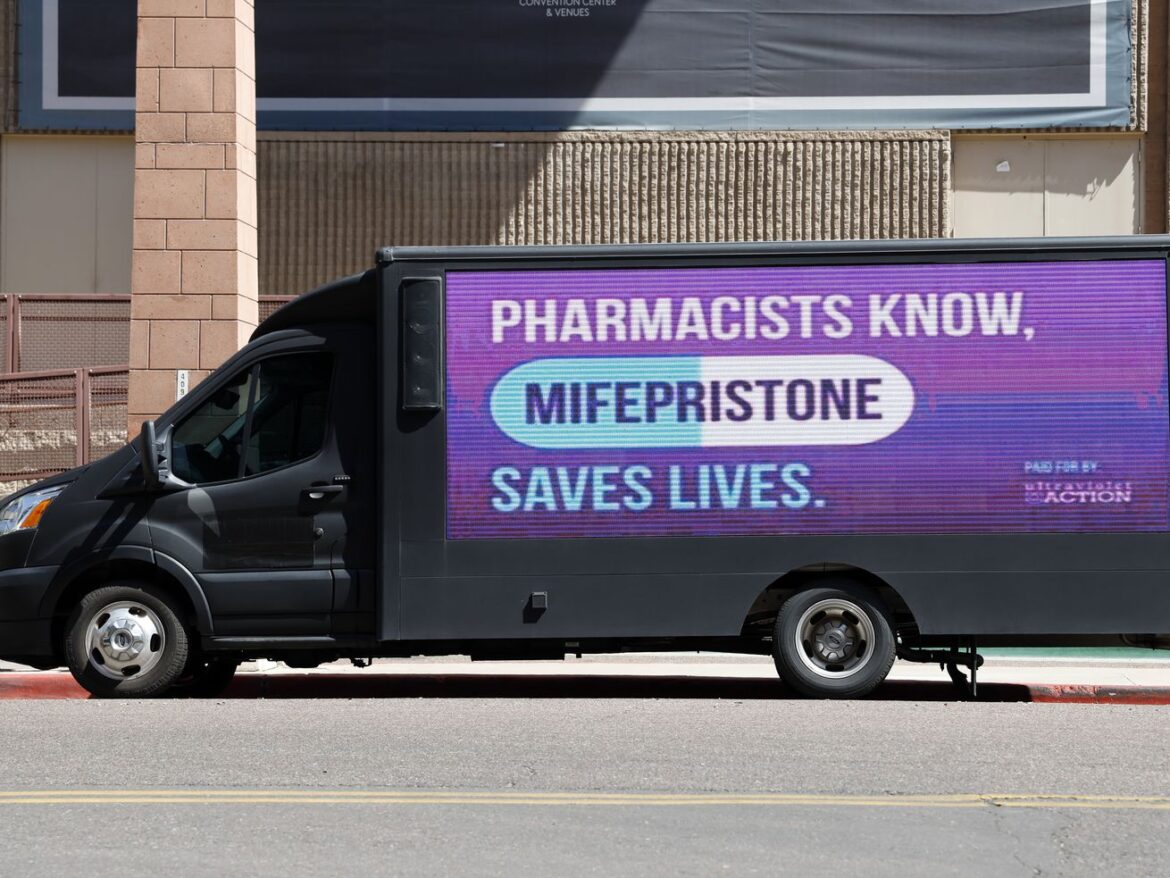It’s controversial politically, not medically.
On April 7, Texas district judge Matthew Kacsmaryk suspended the Food and Drug Administration’s (FDA) 23-year-old approval of mifepristone, a drug used to provide more than half of US abortions. In the days since, there’s been a lot of confusion about what this means for future access to the drug, turmoil in the form of contradictory court orders, and a flood of outcry from Democrats, drug companies, and the general public.
Amid the furor, it’s easy to lose sight of a simple, important fact: This drug is incredibly safe, proven by decades worth of patient data from around the world. In fact, rates of patient deaths due to the drug are lower for mifepristone than they are for Tylenol, penicillin, or Viagra.
Kacsmaryk’s ruling revoked the drug’s approval on the grounds that the FDA hadn’t adequately considered its safety when it initially approved the drug in 2000. And while his judgment might suggest the drug’s risk hasn’t been sufficiently evaluated, it really, truly has. The dissent around mifepristone is entirely political.
Mifepristone is “not medically controversial at all,” said Elizabeth Raymond, an OB-GYN and scientist at Gynuity, a global reproductive health organization. “It’s been used for 23 years in this country and even longer around the world, and the incidence of serious complications” — most of them treatable — “is extremely, extremely low,” she said.
Worldwide, scientists, doctors, health authorities, and patients have agreed on this simple fact, over and over again.
Here’s why so many experts feel so confident that mifepristone is a low-risk, reliable, and sensible drug.
An abundance of data shows mifepristone is extremely safe
Mifepristone works by blocking the progesterone hormone. During pregnancy, this hormone helps keep the lining of the uterus intact; without it, a pregnancy cannot go on.
But mifepristone isn’t enough to end a pregnancy: If the uterus isn’t emptied after an abortion, there’s a high risk of bleeding or infection that could be life-threatening to the patient. That’s why, 24 to 48 hours after taking mifepristone, people getting medical abortions then take misoprostol. That drug relaxes the opening to the uterus and helps the uterus contract and empty itself.
When mifepristone was first FDA-approved for abortions in 2000, it had already been in use in France since 1988. Back then, there was already a fair amount of data suggesting the drug, in combination with a medication like misoprostol, effectively ended pregnancies in 95 percent of the people who took it for that purpose. Additionally, its side effects were mild and included nausea and vomiting, dizziness, weakness, abdominal pain, and headache.
Still, at the time of the drug’s US approval, the FDA placed several restrictions on its distribution, among them a requirement that doctors prescribing it report any hospitalization, transfusion, or other serious events to the agency.
Many FDA-approved drugs come with some safety risks. We can’t expect any medicine to have no potential side effects; what’s important is that we understand them. In mifepristone’s case, the high level of scrutiny means that over the last 23 years, “huge amounts of data” on the drug have accumulated, said Raymond. And what it unambiguously shows is that “medication abortion with mifepristone and misoprostol is very, very safe,” she said.
A 2013 report Raymond led reviewed results from 87 studies, which included data from more than 45,000 people who’d had medical abortions worldwide. Like earlier studies, the review showed that the drug combination effectively ended pregnancy in 95 percent of patients. (Most of the remaining 5 percent needed surgical intervention to complete the abortion.)
It also showed that serious side effects — that is, symptoms so severe they required hospitalization — were very rare. The most common ones were vaginal bleeding, pelvic pain, and infection. Symptoms this serious occurred in only 3 out of every 1,000 patients, and only 1 out of 1,000 needed a blood transfusion.
The study also found that about 1 percent of people remained pregnant after taking mifepristone — the outcome abortion providers were most concerned about. But the researchers identified some practices that lowered the risk of this outcome, most of them related to misoprostol’s dosage amount, timing, and administration route (e.g. whether it was swallowed versus allowed to be absorbed through a mucous membrane like the one inside the vagina or the lining of the cheek).
Professional organizations changed their guidelines to incorporate these protective practices, and in 2016, the FDA did, too.
The agency also increased eligibility for medical abortion using mifepristone: Although its initial approval allowed the drug to be used at up to seven weeks of pregnancy, the 2016 revision allowed it any time before 10 weeks. The change was another signal of what providers and patients all over the world already knew: The drug is safe.
More recent data points to mifepristone’s enduring safety, including a Canadian study published earlier this year showing persistently low rates of severe side effects. And for Americans, taking mifepristone is far safer than pregnancy: In 2012, the death rate associated with childbirth was 14 times that associated with abortion.
“Every time mifepristone is in a study, it’s shown to have the same safety profile, the same efficacy, the same high rates of satisfaction with people using it,” said Carrie Cwiak, an OB-GYN and abortion provider at Emory University School of Medicine in Atlanta. “It’s beyond reproach.”
Mifepristone is also safe for other uses. “It’s an effective tool for an OB-GYN, aside from medication abortions,” said Cwiak. The drug can also help manage uterine fibroids and a hormonal disorder called Cushing’s disease. Hence, banning it outright leaves doctors with one less safe drug in their toolkit for managing other conditions.
Mifepristone is part of a special safety monitoring program
The restrictions that were part of the FDA’s initial mifepristone approval have changed over the years. At first, in addition to mandating that prescribers report side effects to the FDA, the agency also required that only doctors with certain skills — generally, OB-GYNs and some family medicine doctors — prescribe the medication. The FDA also required that women receive an approved medication guide and sign an agreement summarizing the drug’s uses and risks.
In 2011, the FDA rolled mifepristone into its new system for monitoring drug safety, known as the Risk Evaluation and Mitigation Strategy (REMS). Under this system, additional restrictions were placed on the medication. Among them was the requirement that patients get mifepristone in person from a specially certified prescriber, rather than simply picking it up from a retail pharmacy or by mail like most other medications.
If mifepristone was so safe, why did it need this kind of special safety monitoring?
Well, it didn’t, say scientists and experts.
For starters, the REMS requirements did nothing to reduce its already low risks. Any bleeding or infection related to the drug wouldn’t set in until at least 24 hours after taking it, well after a patient had picked it up. Additionally, the new REMS reduced the amount of control and privacy people had in accessing abortions. And the effects were expected to have the worst effects on the people who already faced big obstacles to care, including those living in rural areas and Black and Indigenous Americans.
“What was the point of doing that?” Raymond said of the REMS restrictions. “How is that supposed to help mitigate these problems?”
Physician groups and advocates protested the REMS — Raymond and her team among them — and in 2021, the FDA again modified its restrictions to remove the in-person dispensing requirement. But the drug is still one of only 61 of more than 20,000 FDA-approved prescription drugs that currently have a REMS program.
Although Kacsmaryk’s ruling hinges on an argument that the FDA ignored safety concerns, the agency has arguably done the opposite, keeping an overabundance of guardrails in place for a drug with an extremely strong safety record.
It’s unclear exactly why that is, but Raymond suspects it’s in part due to the FDA’s slow-moving nature: “They’re not risk-takers,” she said. Because the agency often gets criticized when an approved product has side effects — but rarely gets a pat on the back for expanding access to products — it often acts out of an abundance of caution, she said.
What’s clearer is that no efforts to restrict mifepristone access have a basis in the medical evidence. Claiming otherwise doesn’t make any sense, said Cwiak. “If they don’t agree with access to mifepristone, they don’t agree with access to abortion, then just say that,” she said. “But don’t make this a discussion about safety when you have no leg to stand on.”



